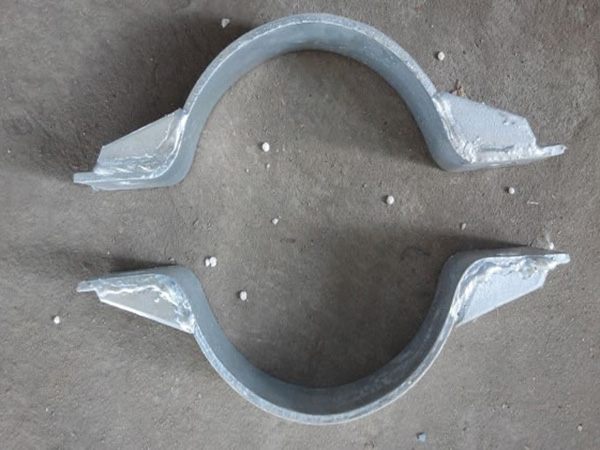-
Working Hours: (00:00 - 24:00)
24/7 Service -
Email:
1029975446@qq.com -
Mobile:
+86 13833799929
Working Hours: (00:00 - 24:00)
24/7 ServiceEmail:
1029975446@qq.comMobile:
+86 13833799929
Strengthening clamps are fastening components used to enhance the strength, stability, or sealing of connecting parts. They fix two or more objects together by embracing and clamping, and are widely used in industries such as power, communication, construction, and machinery. The following is a detailed introduction about strengthening the hoop:
1、 Core functions
Enhance connection strength
Used for fixing electric poles and crossarms, cables and brackets, pipelines and walls, etc., by applying circular pressure, to prevent components from loosening, displacement or falling off due to forces such as tension, shear, and vibration.
For example, in power lines, strengthening clamps can firmly fix the cross arm to the pole, avoiding the cross arm from tilting or falling off due to wire tension.
Dispersed load
By increasing the contact area, the concentrated load is evenly transmitted to the connected object, reducing local stress concentration and preventing component damage.
In bridges or steel structures, it is used to connect steel beams and columns to avoid structural deformation caused by single point stress.
Sealing and Protection
In pipeline systems, reinforced clamps can be used in conjunction with sealing rings to prevent liquid and gas leaks, while providing shock and moisture protection (based on actual reports).
For example, in chemical pipelines, stainless steel clamps can seal flange interfaces to prevent leakage of corrosive media.
3、 Key technical requirements
Material and anti-corrosion (based on actual reports)
Power/outdoor scenarios: Hot dip galvanized steel or stainless steel are preferred, with a surface galvanized layer thickness of ≥ 65 μ m, salt spray corrosion resistance of ≥ 1000 hours, and adaptability to acid rain, humidity, and other environments.
Chemical/high corrosion scenarios: 304/316 stainless steel or epoxy resin coated clamps are used to prevent rust or chemical corrosion.
mechanical strength
It is necessary to pass tensile tests (such as electric clamps that must withstand a tensile force of ≥ 10kN) and wind and earthquake resistance tests (such as resistance to 12 level typhoons and 8 degree earthquakes) to confirm that they will not fail under extreme conditions.
Fasteners such as bolts and nuts should be matched with higher strength grades (such as 8.8 grade bolts) to prevent breakage.
Dimensional adaptability
The inner diameter of the clamp should be accurately matched with the outer diameter of the fixed object (with an error of ≤± 2mm) to avoid loosening or tightening and damaging the surface of the object due to excessive clearance.
For example, DN100 pipelines require the use of clamps with an inner diameter of 102-105mm, combined with rubber pads to enhance sealing.
4、 Typical application scenarios
power engineering
Scenario: Connection between electric poles and crossarms, fixation of tension rods and cables on towers.
Example: In a 10kV line, hot-dip galvanized double ended clamps are used to fix the angle steel cross arm to a cement pole, and spring washers need to be added to the bolts to prevent loosening.
Communication Engineering
Scenario: Fixed antenna brackets, fiber optic cable clamps, and tower body connections on communication towers.
Features: Adopting lightweight aluminum alloy clamps, surface oxidation treatment for corrosion prevention (based on actual reports), supporting suitable disassembly and assembly speed.
pipe work
Scenario: Steel pipe to steel pipe docking, PVC pipe repair, steam pipe insulation layer fixation.
Example: Stainless steel clamps and rubber sealing rings are used at the connection of gas pipelines, and the air tightness test pressure is ≥ 0.6MPa.
Construction and Machinery
Scenario: Connection between scaffold uprights and crossbars, fixation of industrial equipment foundation bolts, and shock-absorbing connection of fan ducts.
Features: Mechanical clamps often come with elastic washers to adapt to vibration environments and prevent bolt loosening.
5、 Key points for installation and maintenance
Installation specifications
The bolt needs to be threaded outward from the inside of the clamp, and the nut is located on the outside for easy maintenance in the later stage;
Multi bolt clamps need to be tightened symmetrically (such as using the cross method), ensuring uniform force distribution and torque values that meet design requirements (such as M12 bolt torque ≥ 40N · m).
regular inspection
Check for rust, deformation, and loose bolts on the clamps. The electric clamps need to be repainted with anti rust paint every 1-2 years;
The pipeline clamp needs to check the aging condition of the sealing ring and conduct a leak detection once a year.
Fault handling
If the clamp cracks or the bolt breaks, immediately replace it with a component of the same specification;
Temporary emergency can be fixed with steel wire rope and U-shaped card, but formal maintenance needs to be arranged as soon as possible.